Since neither Valdez nor Carr had managed to build the Axe that Gene envisioned Gene took a "next man up" mentality: next in line turned out to be Kramer. The Kramer story begins in the early 70's when Gary Kramer and Travis Bean had a partnership; Kramer was basically the financier and handled administrative duties, simply because he saw potential in aluminum neck guitars, while Travis handled the guitar side. (www.garykramerguitar.com) Kramer soured on the relationship because Travis secured the patent for his aluminum neck under his own name and not registered to the company. Kramer is refreshingly upfront about the fact that he just took what Travis had created and tweaked it: instead of a solid aluminum neck he chose a T-profile with inlayed wood sections which also served to combat what Kramer felt was a relatively heavy neck on the Travis Bean. According to the 1979 Kramer catalog the design idea was to "combine the strength of forged aluminum with the warmth of wood for playing ease and comfort". Lest anyone confuse the two aluminum beasts Kramer also opted for a forked (or split) headstock.
By 1980 Kramer had slowly moved from more or less traditional dual-cutaway shapes into more bold designs, the XL and XK series had some angular and "modern" body shapes so the Axe shape was probably not perceived as particularly odd. Of course, that doesn't begin to explain why Gene should choose to work with Kramer and decide to try the aluminum neck concept - as far as I can tell Gene himself has never mentioned it and there are actually relatively few facts available about the Kramer Axe. The only possible connection I've been able to find is a mention by Paul in an interview: "Then Kramer just made me a guitar I haven't had the chance to use yet, which looks like a stick." (Sounds 1980) Kramer had just one "stick" guitar, the Duke, which happens to be the last of Kramer's aluminum neck guitars. It wasn't revealed to the public until 1981 but prototypes were surely available for the right person to try. It is a weak and incidental connection but it is the only one I've found.
By 1980 Kramer had slowly moved from more or less traditional dual-cutaway shapes into more bold designs, the XL and XK series had some angular and "modern" body shapes so the Axe shape was probably not perceived as particularly odd. Of course, that doesn't begin to explain why Gene should choose to work with Kramer and decide to try the aluminum neck concept - as far as I can tell Gene himself has never mentioned it and there are actually relatively few facts available about the Kramer Axe. The only possible connection I've been able to find is a mention by Paul in an interview: "Then Kramer just made me a guitar I haven't had the chance to use yet, which looks like a stick." (Sounds 1980) Kramer had just one "stick" guitar, the Duke, which happens to be the last of Kramer's aluminum neck guitars. It wasn't revealed to the public until 1981 but prototypes were surely available for the right person to try. It is a weak and incidental connection but it is the only one I've found.

Considering the history of Gene's basses up to this point - the myriad of modifications of the LoBue and the minor tweaks to the Grabber and Spector - one could be forgiven for thinking that something similar happened with the Kramer Axe: Gene got a bass and then tried a few different things out until he was (more or less) satisfied. I for one was sure that's how the story played out but alas, the truth is more complex than that.
We'll look at the differences between the Axes Gene played and the production model in excruciating detail later on; suffice to say that there are elements to both that were handcarved which means that each individual bass can usually be identified and, as photos from the production facility will attest, there were more Axes made specifically for Gene than he has been pictured with.
We'll look at the differences between the Axes Gene played and the production model in excruciating detail later on; suffice to say that there are elements to both that were handcarved which means that each individual bass can usually be identified and, as photos from the production facility will attest, there were more Axes made specifically for Gene than he has been pictured with.
Gene shows up with his first Kramer Axe (KAxe1) on May 22, 1980 for a Waring Abbott photo shoot (as seen above). This particular Axe has 20 frets, a nut with a zero fret, a black P-bass style pickup and Gene's favored Leo Quan Badass bridge. Note the circled "cracks" in the blade which is a detail that was carved by hand on each individual instrument and allows us to identify them. (As we'll see the number of these cracks differed as did their shape.) A different photo from this particular shoot was used in the advertisement for the Axe in 1980 where it is described as "Designed by Gene Simmons, hand-crafted exclusively by Kramer."
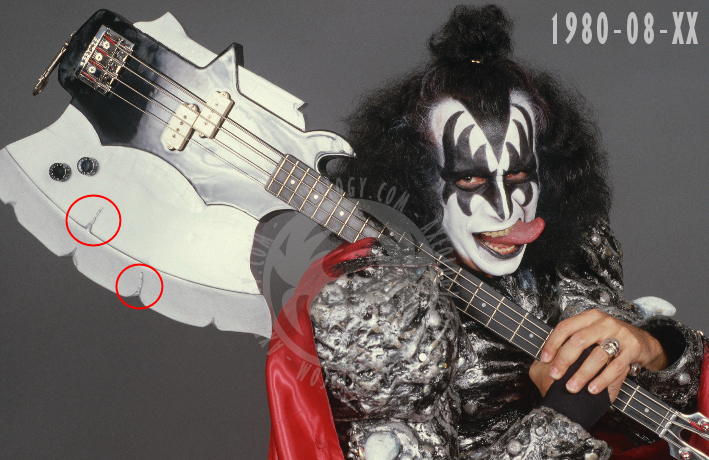
After this it gets slightly harder to say something for sure. Once the European tour starts in late August Gene seems to travel with two Axes. The first, which makes it the fourth one so far (Kaxe4), shows up backstage in Rome, Italy on 80.08.29. The photos I've seen aren't exactly stellar in quality but to my eyes this bass isn't either of the previous ones. It lacks the second "upper crack" of KAxe1 and has a much less pronounced "lower crack" compared to Kaxe3 (both these areas are circled in the photo on the left). Other than that it seems to have similar specs to the first one. One curious thing is that the Axe never seemed to see the stage. So far I've seen no shots of it actually being used live during the European tour. Any evidence to the contrary will be accepted gladly.
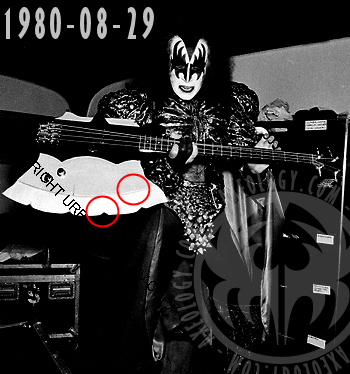
And then, as usual, we get to our first problem. I've yet to see any still photos from the Shandi video shoot (which happened some time mid-June) and the video has only some fleeting images of the Axe used. The video clip here shows the part of the video that shows the blade of the Axe best and to my eyes there are two (or possibly three) "cracks" in the upper part of the blade and these aren't in quite the same spots as on KAxe1. Based on that I consider the Kramer used in the Shandi video to be number two (KAxe2).
This also lends some creedence to the anecdote shared by Peter in his autobiography. On p. 199 he mentions the emotions when he realized that this video shoot actually was his swan song with the band and asked Gene if he could have his bass (which Gene graciously let him have).
As far as I can tell there is no Axe used during the show at the Palladium on 80.07.25 so the next time we got to see one is at a Lynn Goldsmith photo shoot from August. It's easy to just glance at the photos and think that this as KAxe1 or 2 but with changed pickup covers, but the handcarved "cracks" on the blade are markedly different from at least KAxe1. Apart from this KAxe3 has the same specs: 20 fret neck, zero fret and the Badass bridge. Interestingly the color of the blade on KAxe3 seems more like a light grey than the almost silvery finish of KAxe1 and KAxe2 at certain angles (see the video clip and this photo of KAxe1).
As far as I can tell there is no Axe used during the show at the Palladium on 80.07.25 so the next time we got to see one is at a Lynn Goldsmith photo shoot from August. It's easy to just glance at the photos and think that this as KAxe1 or 2 but with changed pickup covers, but the handcarved "cracks" on the blade are markedly different from at least KAxe1. Apart from this KAxe3 has the same specs: 20 fret neck, zero fret and the Badass bridge. Interestingly the color of the blade on KAxe3 seems more like a light grey than the almost silvery finish of KAxe1 and KAxe2 at certain angles (see the video clip and this photo of KAxe1).
The fact that the Axes never got on stage makes it even more strange that he brought two of them with him. The fifth Axe (KAxe5) is used for the Rock Pop taping 80.09.01 and this one is completely different than the previous ones: it's got a 24 fret neck, two humbuckers, and a shorter scale (the bridge is closer to the neck). It also has an added detail in the paint job as there's a slight shadow added at the top of the blade. (This is something that shows up in several photos under various lighting conditions so it's not a play of the light.) This particular bass also has a slightly different shape to the small "horn" closest to the neck.

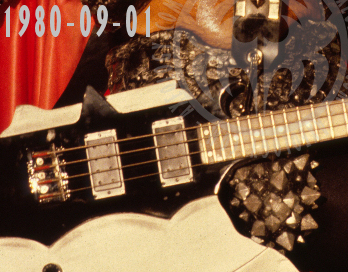
The Axe doesn't actually get to see the stage until the band travels to Australia in November and now, true to form, the modifictations begin. The bass that Gene uses live during this part of the tour is KAxe5 but now there's only one humbucker. (This mod is actually one of the more professional ones that Gene had done to any of his basses as we'll see later.)
First time it shows up is in the Countdown footage shot in Perth on 1980.11.08 but that footage and the stills from it doesn't show us much other than that it's a short-scale, single humbucker Axe. The photo on the left here shows the details of the blade. (This photo has been identified as Sydney by various sources but compared to newspaper clippings from the time it appears that it is rather from one of the shows in Perth.)
This bass has 24 frets (count them!) and a distinctive pair of cracks which matches the ones on the bass used for the Pop Rock performance. The cavity for the second humbucker was carefully filled and there was a new finish applied over the "fix". This bass has also replaced the zero fret with a new, very thick, brass nut.
First time it shows up is in the Countdown footage shot in Perth on 1980.11.08 but that footage and the stills from it doesn't show us much other than that it's a short-scale, single humbucker Axe. The photo on the left here shows the details of the blade. (This photo has been identified as Sydney by various sources but compared to newspaper clippings from the time it appears that it is rather from one of the shows in Perth.)
This bass has 24 frets (count them!) and a distinctive pair of cracks which matches the ones on the bass used for the Pop Rock performance. The cavity for the second humbucker was carefully filled and there was a new finish applied over the "fix". This bass has also replaced the zero fret with a new, very thick, brass nut.
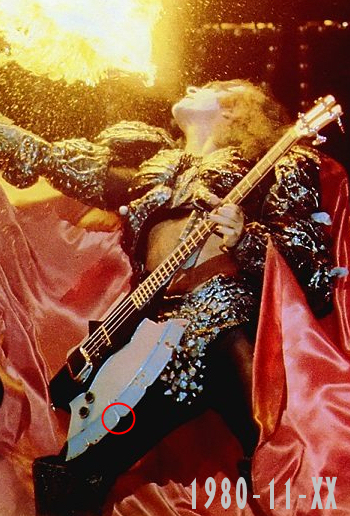
Shortly thereafter, the photo on the right isn't properly dated in my archives, KAxe5 takes the final step towards being a true Gene Simmons bass with the addition of a chrome Fender-style bridge cover. Note the brass nut. (Since the bass doesn't have this look in any of the Sydney footage this photo has to be from November 25-December 3 but that's as far as I can narrow it down.)
One thing that's interesting here is that there appears to be residue from Gene's blood-spitting on the blade of KAxe5 but it's not used for that in the video from Sydney.
One thing that's interesting here is that there appears to be residue from Gene's blood-spitting on the blade of KAxe5 but it's not used for that in the video from Sydney.

In what might be considered a rather strange move Gene decides that the new-look, high-concept KISS of the Elder, a project designed to woo the critics, will be best served by an Axe bass. Although not technically part of the promotion for The Elder, Gene brings yet another Kramer Axe (KAxe6) to Mexico for the Applausos taping.
KAxe6 has 20 frets, a long scale, a massive-looking humbucker which is most likely a DiMarzio Model One, and some different marks on the blade. Sadly the photos I have available to me from the Mexican jaunt leave a lot to desired as far as quality goes but thankfully KAxe6 is used for several other photo and video shoots over the coming months.
As usual the handcarved cracks on the blade can easily differentiate between the two as in these photos from Rock Pop and the World Without Heroes taping over Halloween weekend 1981. One feature KAxe5 and KAxe6 share is the massive brass nut as seen here. This nut is decidedly larger than anything Gene had used before and I assume it was to "fill in" the additional space created by using a nut and a zero fret.
Although the #2 Spector was called upon for the actual live performance on Fridays, a choice that probably reflects Gene's comfort level with his trusted Spector more than it does any dissatisfaction with the Kramer, the Axes were used for the rest of the promotional work surrounding The Elder.
As usual the handcarved cracks on the blade can easily differentiate between the two as in these photos from Rock Pop and the World Without Heroes taping over Halloween weekend 1981. One feature KAxe5 and KAxe6 share is the massive brass nut as seen here. This nut is decidedly larger than anything Gene had used before and I assume it was to "fill in" the additional space created by using a nut and a zero fret.
Although the #2 Spector was called upon for the actual live performance on Fridays, a choice that probably reflects Gene's comfort level with his trusted Spector more than it does any dissatisfaction with the Kramer, the Axes were used for the rest of the promotional work surrounding The Elder.


The footage below from Sydney 80.11.22 show the Axe used for two songs, Firehouse and Talk to me, and although details are hard to see in this footage two things that are obvious is that this is a short-scale bass and that the bridge is uncovered.
That's right, Axes in plural. Although it saw very limited "action" Gene still retained KAxe5 during this time and used it for the Solid Gold taping on December 7. The photo on the left below is less than stellar quality but it is good enough to show a bass with 24 frets (again, count them) and a short scale. (The available footage, although decent enough in quality, doesn't show any details.)
For the last "hurrah" of the desperate media campaign surrounding The Elder Gene used KAxe6 for the sattelite performance from Studio 54 on January 28. Note the 20 fret neck, long scale and the lack of a bridge cover. (The knobs differ between these two basses as well but that's a minor detail compared to the other differences.)
For the last "hurrah" of the desperate media campaign surrounding The Elder Gene used KAxe6 for the sattelite performance from Studio 54 on January 28. Note the 20 fret neck, long scale and the lack of a bridge cover. (The knobs differ between these two basses as well but that's a minor detail compared to the other differences.)
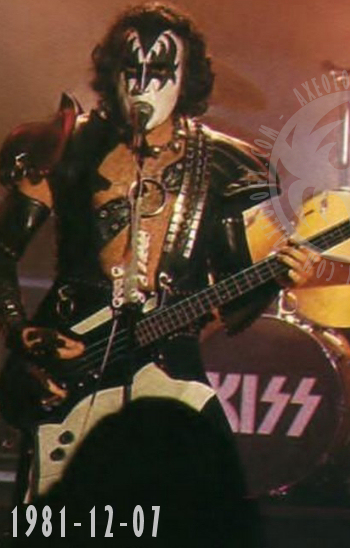
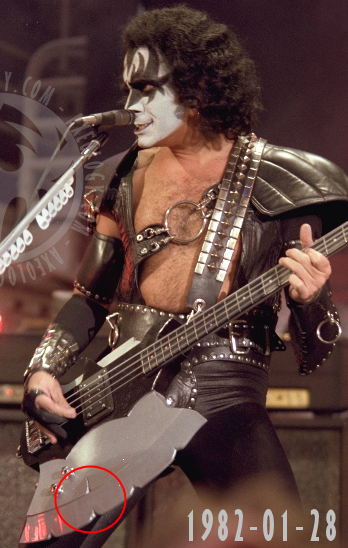

In 1982 Gene found EMG active pickups and had them installed in a few of his basses. (For some reason Spector #1 escaped this and retained the old humbucker until it re-surfaced in 1990.) As far as I've been able to find out KAxe5 disappears around this time; it's not used for any of the photo shoots in 1982 and all live shots of a Kramer Axe during the 10th Anniversary Tour turn out to be KAxe6. KAxe6 gets the EMG treatment some time between late September and late October. The photo shoot with Bernard Vidal which produced this photo, also seen on page 5 of the tour book for the 10th Anniversary Tour, seems to have taken place late September or early October 1982, and it shows KAxe6 with a large humbucker and lacking a bridge cover.
When the band steps on the Zoetrope sound stage on October 28 for a photo shoot (and to record the video for I Love it loud) KAxe6 has gotten a bridge cover and the old humbucker is gone and replaced by an EMG humbucker that is a lot closer to the bridge. Now, the moving of the pickup is a little odd. Gene had modifications done to Spector #1 as well and there he chose to add a pickguard-like frame to the pickup rather than to relocate it which would require new routing for the new pickup. (Moving the EMG humbucker this far back would also have resulted in losing some bass frequencies but that might have been a minor concern.) The only reason for moving the pickup that I can think of is that the active electronics of the EMG, which includes a battery compartment, would require routing out the body anyway so trying a new position for the pickup was an easy decision to make.
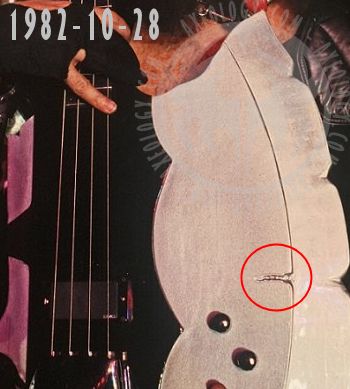
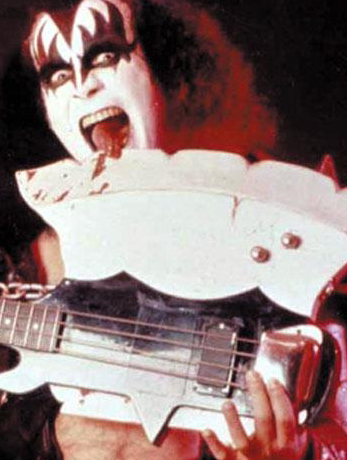
True to form, Gene evidently took a "good enough" approach to this modification. Rather than trying for something more elaborate that may or may not have looked better, it appears that whoever performed this latest modification for Gene just applied a wide strip of black tape over the routing left from the previous pickup. It is hard to fault this choice though as it is exceedingly hard to spot this piece of tape, in most photos it's impossible, and it certainly passed the "five rows out" test that KISS has applied throughout their career. It takes a keen eye, and quite frankly you almost have to know what to look for, to spot it even in promotional photos from the day. Case in point is this photo taken by Didi Zill on November 30 in Munich, Germany. Here it's actually visible although just barely; in most other photos it's no use even trying.

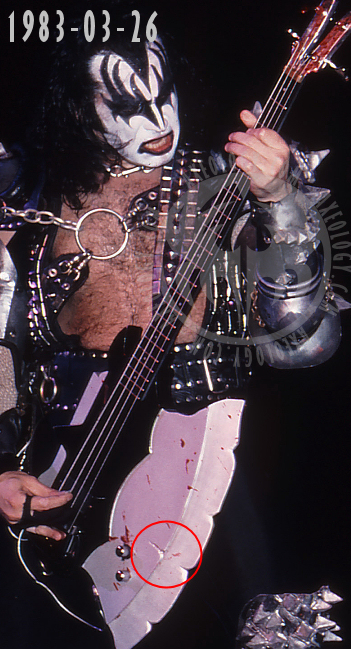
KAxe6 doesn't get much stage time during the 10th Anniversary Tour but it seems to have been the preferred choice for Gene's blood-drooling solo spot. More often than not we see it covered in blood as on the left in Irvine Meadows, CA or in this photo from an unknown date, but it's also seen frequently during the tank finale.
KAxe6 travels to South America for the last shows in makeup and is then summarily retired in favor of the Jackson Axe. This move is a little odd unless it was mostly a business decision. KAxe5 and KAxe6 has played a fair number of shows by 1983 and any nagging doubts about the aluminum neck or the placement of the pickup would surely have come to light earlier. (As the 1980 European tour shows Gene apparently felt no need to use the Axe unless it fit his taste; had he felt uncomfortable with KAxe6 during the 10th Anniversary Tour it would surely have been left on the side of the stage.)
As we'll see the deal Gene had with Kramer was short-lived and produced a very limited number of commercially available Axes and since Gene held the patent for the Axe bass (it was registered in February 1980 and had a running term of 14 years) there might have been a wish from Gene's side to actually get a proper commercial venture going.
KAxe6 travels to South America for the last shows in makeup and is then summarily retired in favor of the Jackson Axe. This move is a little odd unless it was mostly a business decision. KAxe5 and KAxe6 has played a fair number of shows by 1983 and any nagging doubts about the aluminum neck or the placement of the pickup would surely have come to light earlier. (As the 1980 European tour shows Gene apparently felt no need to use the Axe unless it fit his taste; had he felt uncomfortable with KAxe6 during the 10th Anniversary Tour it would surely have been left on the side of the stage.)
As we'll see the deal Gene had with Kramer was short-lived and produced a very limited number of commercially available Axes and since Gene held the patent for the Axe bass (it was registered in February 1980 and had a running term of 14 years) there might have been a wish from Gene's side to actually get a proper commercial venture going.
Before diving into the production model Kramer Axe and some interesting things about the construction of Gene's Axes, let's play "whatever happened to". KAxe6 was summarily retired after the 10th Anniversary Tour and in its stead there appeared the Jackson Axe. The photo on the right is from the late 80's (presumably 1987) and show parts of "Fat" Vinny Gonzales collection before it was broken up and sold. It's not the greatest photo but it clearly shows a Kramer Axe with a brass nut, a 20 fret neck, and an EMG humbucker. Vinny befriended the band and got a lot of stuff from KISS throughout the years so it seems plausible that the bass was given to him after Gene got the Jackson.
After that this bass shows up at the KISS Expo in 1993. The video is available on YouTube courtsey of Bill Baker and although it's lacking in detail it shows a long-scale Kramer Axe with 20 frets. After that I have no clue. It's not been auctioned as far as I know so chances are that it's still in collector's hands somewhere in the World.
After that this bass shows up at the KISS Expo in 1993. The video is available on YouTube courtsey of Bill Baker and although it's lacking in detail it shows a long-scale Kramer Axe with 20 frets. After that I have no clue. It's not been auctioned as far as I know so chances are that it's still in collector's hands somewhere in the World.

KAxe5 is last seen at the Solid Gold taping as mentioned above and then it too seems to fall into collector's hands. In July 1990 it was part of the Rock n Roll Expo in New Jersey where it was purchased by its present owner Jay Bianco of the tribute band Alive n' KISSin' for the handsome sum of $2,000. The photo on the left (used by kind permission from Jay) shows the instrument as it appears today. Note the short scale, the 24 fret neck, and the huge brass nut. The thing that truly identifies this as the bass Gene played are the handcarved "cracks" on the blade and they match the photos from the Rock Pop taping.
For some reason, this instrument received much more attention when it was altered than did most of Gene's other basses. Recall the strip of tape covering the holes on the LoBue, the open hole in Spector #1 that was variously taped or (poorly) painted over, and the really amateurish piece of tape covering the old pickup route on KAxe6. When KAxe5 lost it's neck pickup the cavity was very carefully filled in and a new finished applied over it which can be seen in this close-up.
KAxe5 is retired from active duty these days and safely in storage.
For some reason, this instrument received much more attention when it was altered than did most of Gene's other basses. Recall the strip of tape covering the holes on the LoBue, the open hole in Spector #1 that was variously taped or (poorly) painted over, and the really amateurish piece of tape covering the old pickup route on KAxe6. When KAxe5 lost it's neck pickup the cavity was very carefully filled in and a new finished applied over it which can be seen in this close-up.
KAxe5 is retired from active duty these days and safely in storage.
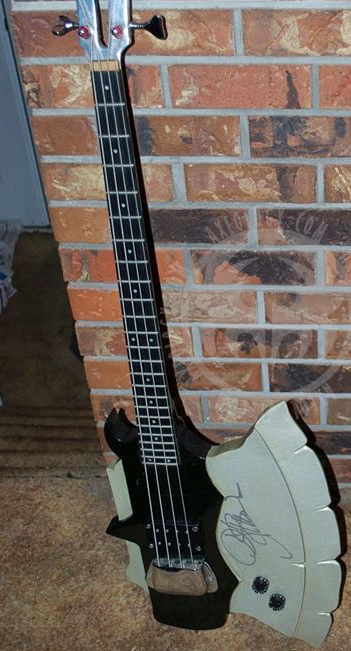

In order to talk about the construction of Gene's version of the Kramer Axe it's necessary to compare it to the production model Axe. First, similarities. Obviously, both Gene's Axes and the production Axe had the aluminum neck. The T-profile had inlayed wood sections on the back to combat the cold feel and ridiculously neck-heavy instrument that was the Travis Bean. Interestingly what wood was used in these neck inlays is not specified by Kramer in the documents I've found, only that they were there which is fairly obvious to anyone. According to previous Kramer employees the wood inlays on the aluminum necks were mostly, but not always, of the same wood as was used on the body. (For completist purposes the necks were produced by Kaiser Aluminum out of Erie, PA.)
The fretboard was made of ebonol, a synthetic "wood substitute" that is actually a paper-based high-pressure laminate. The name dervies from the fact that it is similar in appearance and has characteristics similar to ebony. According to the promotional material for the Kramer Axe ebonol has "the look and feel of fine ebony with none of the problems associated with wood".
The fretboard was made of ebonol, a synthetic "wood substitute" that is actually a paper-based high-pressure laminate. The name dervies from the fact that it is similar in appearance and has characteristics similar to ebony. According to the promotional material for the Kramer Axe ebonol has "the look and feel of fine ebony with none of the problems associated with wood".
All Kramer aluminim neck guitars had aluminum dots as inlays. There were some exceptions but those were high-end models and although they had pearl inlays they were also of a different shape, a "crown"-like shape. Any Kramer Axe bass with these crown inlays, of which I have seen one, is not from the 1980-81 production run. This, and the fact that the inlays on Gene's Kramer Axes don't really vary in appearance (as seen on the right), leads me to believe that all of his Krames Axes has aluminum dot inlays. (Also making a case for aluminum dot inlays; in some instances they actually reflected light in a manner similar to the frets as seen here.)
Production model Axes had maple bodies and, based on photo evidence later, this seems to hold true for Gene's Axes as well. However, that's where similarities end. Gene was certainly photographed with Axes that had a zero fret, as seen on the right and on KAxe5 at its original appearance on September 1, but once they "graduated" to proper use on stage Gene opted for that massive brass nut.
Production model Axes had maple bodies and, based on photo evidence later, this seems to hold true for Gene's Axes as well. However, that's where similarities end. Gene was certainly photographed with Axes that had a zero fret, as seen on the right and on KAxe5 at its original appearance on September 1, but once they "graduated" to proper use on stage Gene opted for that massive brass nut.
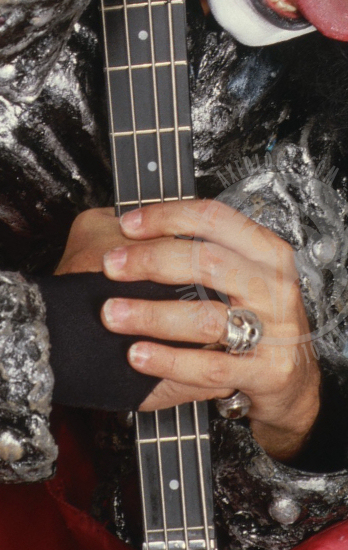
The most obvious difference between Gene's Axes and the production Axe was the body. First, the actual body shape. Gene's Kramer Axes were all more or less straight copies of the Valdez and the second Carr Axes. In comparison the production model Axe lacked the "top" part of the blade as seen below. It also had much "softer" lines and the blade was much less detailed and scuplted.
Finally, two minor but noticeable differences. First, the knobs were changed. KAxe6 first had a strikingly original set of knobs that don't appear on other Kramer instruments from the time that I've seen. (This is in contrast to KAxe5 which had plastic Speed knobs which was used on most aluminum neck models.) They are similar to a Bell knob which you'd find on any old Stratocaster, but these have slightly different proportions and, oddly enough, no knurling. This last detail is probably the main reason why they're changed to more regular, "domed" knobs with knurling once KAxe6 actually gets proper use on stage.
Secondly, the output jack is changed. When KAxe6 first appears it has the same type of output jack as do the production model Axe (and KAxe1) as not seen below on the left since the cable obscures the output effectively. In contrast, photos from November 1982 and onward reveal a square jack plate as seen below right and in the photo above if you take a closer look.
Secondly, the output jack is changed. When KAxe6 first appears it has the same type of output jack as do the production model Axe (and KAxe1) as not seen below on the left since the cable obscures the output effectively. In contrast, photos from November 1982 and onward reveal a square jack plate as seen below right and in the photo above if you take a closer look.

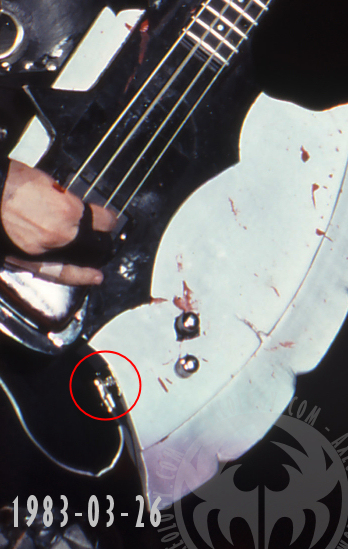
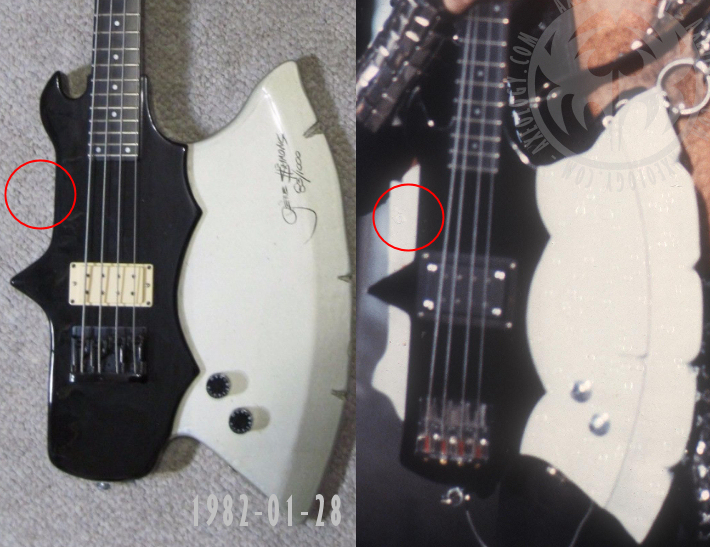

Most of these differences were probably due to financial restraints when it came to mass-producing an instrument such as this. The level of detail seen on the blades of Gene's Axes and the much more time-consuming paint job (more of which later) would have made production costs too high since each bass would essentially have to be handcrafted. In contrast, the production model's only real "handcrafted" elements were the cracks on the blade which, if we're perfectly honest, look rather uninspired on most examples.
In order to make the production model Axe comercially viable the assembly shown on the right was settled on: two parts of the body which could be painted, and worked on, separately before being assembled. (Photo courtsey of the Facebook page KISS My Axe.) Gene's Axes were carved out of a single piece and this resulted in a very different appearance. (These two photos show how the "attachment" of the blade differed.)
In order to make the production model Axe comercially viable the assembly shown on the right was settled on: two parts of the body which could be painted, and worked on, separately before being assembled. (Photo courtsey of the Facebook page KISS My Axe.) Gene's Axes were carved out of a single piece and this resulted in a very different appearance. (These two photos show how the "attachment" of the blade differed.)
Despite these differences both Gene's Axes and the production Axe were made by the Sports factory which did most of the wood work for Kramer. (Dates vary, the most commonly cited is that Sports produced the bodies for Kramer 81-85 but former Kramer employee George Felise claims that the Axes had bodies that were made by Sports and assembled/painted at the facility in Neptune, NJ so chances are they were in business with Kramer in 1980.) And now the story of Gene's Kramer Axes gets a little twist. As seen above Gene was pictured with no less than 6 different Axes during 1980 but the photo below (courtsey of Vintage Kramer) show a grand total of 8 and these are all handcarved in one piece. Judging by the look of the wood they all seem to be made of maple.
